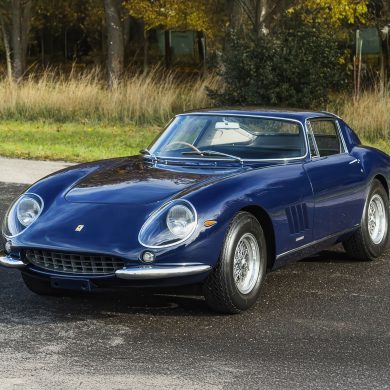
The Monoposto Corsa Indianapolis project’s specific nature was based on several elements, in particular the restoration activities and the historical research by the Ferrari Classiche department’s technicians and to documents from the Ferrari archives. Courtesy of Ferrari SpA, here is the complete analysis of the history, the research and the restoration of the Corsa Indianapolis (chassis 0388).
Ferrari Corsa 375 Indianapolis History (Chassis 0388)
The Monoposto Corsa Indianapolis project starts in the year 1953 with the idea of participating in the Indianapolis 500, but it was not completed, probably due to the numerous projects at the Scuderia department and the various competitions connected. On 21 January 1954 the car was sold to Luigi Chinetti, then Ferrari importer for North America. The following month the car was shown at the New York Motor Sports Show.
The Daytona Speed Week GP, in February 1955, was the car’s first official appearance in a race, where it was driven by Bob Said. The year 1956 was the busiest year for the Monoposto Corsa Indianapolis: in May Giuseppe Farina used the car for a test in Indianapolis, on 15 July it was driven by Carroll Shelby at the SCCA Mount Washington hillclimb and on 22 July at the SCCA Golden Jubilee hillclimb in Indianapolis.
In 1958 the car returned to the factory for modifications for the “Race of Two Worlds” Monza/Indianapolis race, with Harry Schell behind the wheel. The Ferrari was no match for the USAC cars, as Schell finished 12th in the first heat and retired with problems after 15 laps of the second heat. After the competition the car returned to Maranello for repairs and further modifications, including a new Formula One-style coachwork in 1960 bodied by Carrozzeria Fantuzzi. In the same year the car was tested by Cliff Allison at the Modena race track, but the Monoposto Corsa Indianapolis would never see motorsports action again. It subsequently changed owners several times prior to ending up at Ferrari Classiche for a comprehensive restoration.
Historic Research
The historic research for such a particular project started with the identification of the assembly sheet 250/I (Indianapolis). The tubular chassis with extra tubular bracing (with no existing designs) was made by the chassis supplier Gilco.
Naturally it is important to underline the existence of a specific list of components dating from March 1953, entitled “250 Indianapolis,” encompassing components that were specifically designed and identified as “250.” These included clutch, suspensions, hubs, braking system, fuel tank, oil radiator and tank (the car also had a double Houdaille shock absorbers rather than the usual single absorber).

Probably because of the many different racing projects dealt with by the Racing Division at the time, the development of this design didn’t go according to schedule and it was only bench-tested at the end of September 1953. A few days before the other test, a 375 engine was tested, while this was subsequently fitted when the car was delivered to Chinetti.
Restoration Activities
The restoration of such a highly unusual car involved followed Ferrari Classiche’s usual methods for restoration work carried out at the factory, while the running gear was stripped down and verified in correspondence to the original design and state of deterioration, to determine whether the parts could be re-used.
The car’s correspondence to the original design and eventual modifications made by the factory over time were verified through the analysis of the assembly sheet, analysis of the list of components (all of the components, divided by group, required to complete the car). A verification of the components installed and correspondences of the same to the original design was then carried out, followed by a verification of the components’ treatments to ensure that the same were rendered compliant with the initial specifications. This included the engine, gearbox, differential, suspension, brakes, transmission assembly, timing gear, ignition, lubrication, cooling system and exhaust system.
The end result of the extensive Ferrari Classiche restoration process is the one-off Ferrari Monoposto Corsa Indianapolis that is presented in the following photo gallery.
For more information on Ferrari Classiche, visit Ferrari Classiche Restoration Facility – Photo Gallery.
Ferrari Monoposto Corsa Indianapolis – Photo Gallery (click image for larger picture)
[envira-gallery id=”110189″]
[Source: Ferrari SpA]









